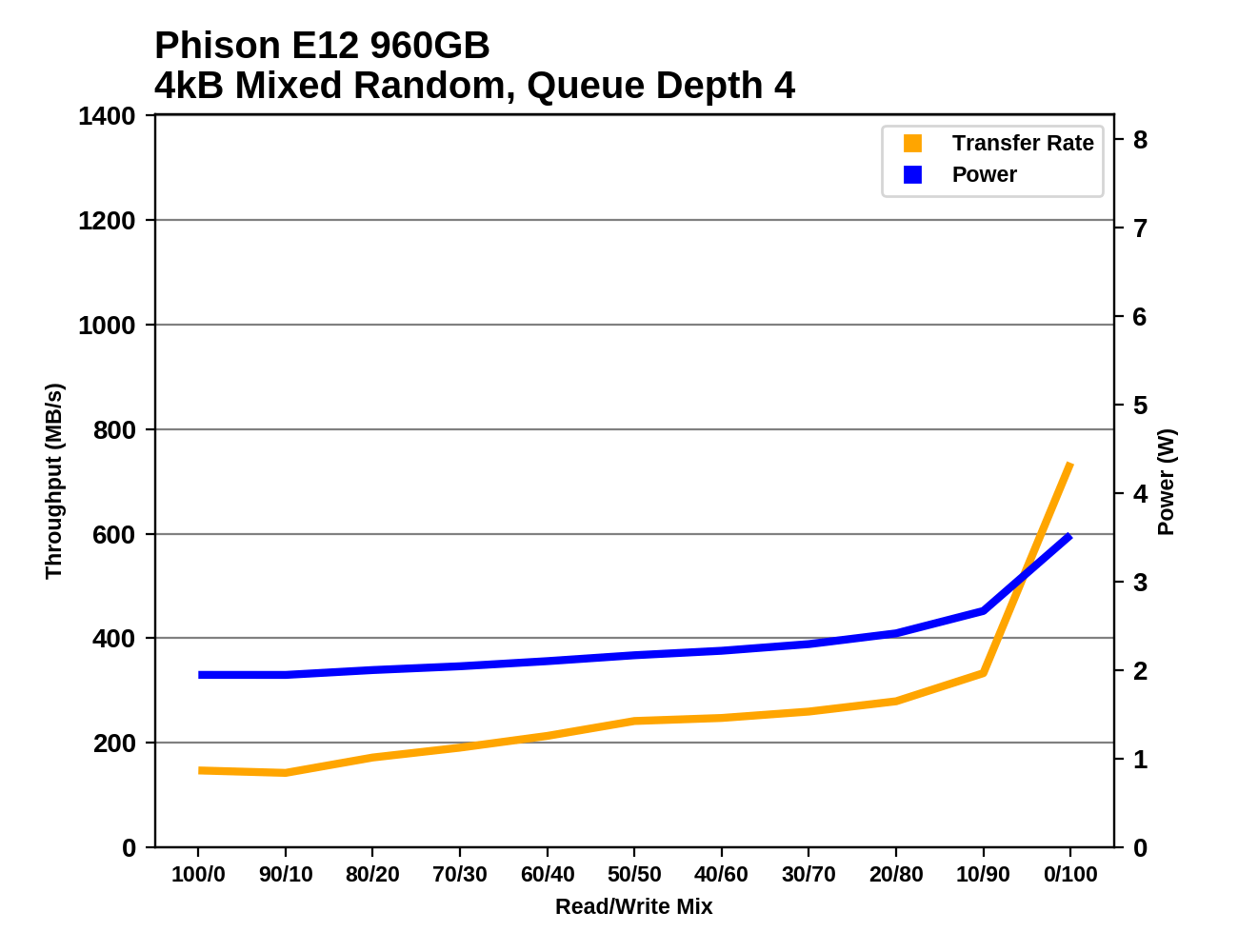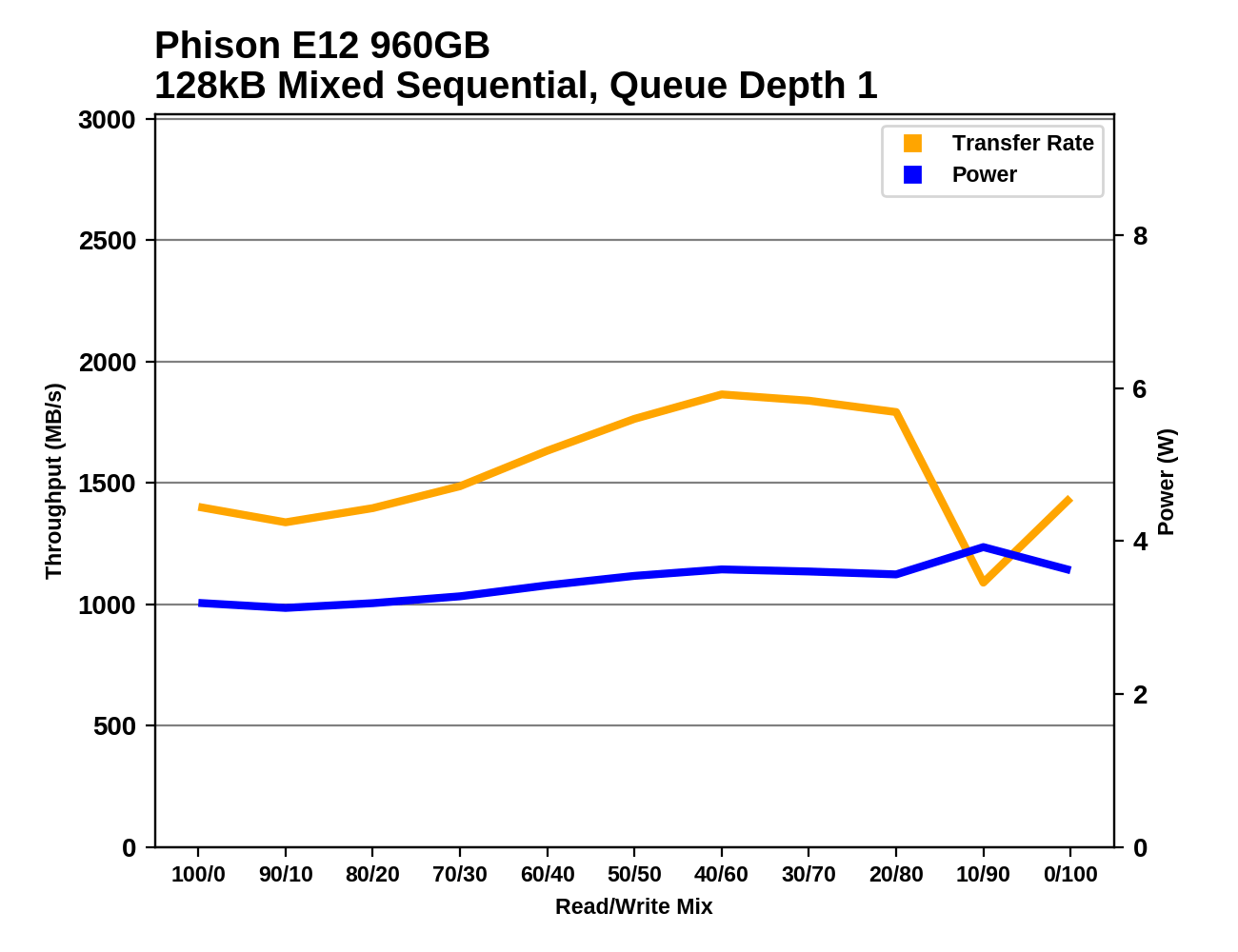The Phison E12 Reference Design Preview: A Next-Gen NVMe SSD Controller
by Billy Tallis on July 18, 2018 10:30 AM ESTMixed Random Performance
Our test of mixed random reads and writes covers mixes varying from pure reads to pure writes at 10% increments. Each mix is tested for up to 1 minute or 32GB of data transferred. The test is conducted with a queue depth of 4, and is limited to a 64GB span of the drive. In between each mix, the drive is given idle time of up to one minute so that the overall duty cycle is 50%.

The mixed random I/O performance of the Phison E12 is unimpressive for its intended market segment: The HP EX920 and WD Black are 20% faster overall and the Samsung 970 EVO is 40% faster. The E12 delivers only a modest improvement over the previous-generation E7 controller.
 |
|||||||||
| Power Efficiency in MB/s/W | Average Power in W | ||||||||
The power efficiency of the Phison E12 during the mixed random I/O test is better than most TLC SSDs, but it is slightly beat out by the low-power Toshiba XG5 and top-performing Samsung 970 EVO, and they're all overshadowed by the extremely efficient WD Black.
 |
|||||||||
The Phison E12 gains performance slowly as the test progresses from pure reads toward write-heavy workloads. At the very end of the test the high random write speed of the Phison E12 helps bring the average up, but not enough to overcome the drives that show much more pronounced performance growth throughout the test.
Mixed Sequential Performance
Our test of mixed sequential reads and writes differs from the mixed random I/O test by performing 128kB sequential accesses rather than 4kB accesses at random locations, and the sequential test is conducted at queue depth 1. The range of mixes tested is the same, and the timing and limits on data transfers are also the same as above.

The mixed sequential I/O performance of the Phison E12 is very good, beating all TLC drives except the Samsung 970 EVO, which is only about 7% faster overall.
 |
|||||||||
| Power Efficiency in MB/s/W | Average Power in W | ||||||||
The power efficiency of the Phison E12 on the mixed sequential test is again very good, but still can't match the WD Black. Toshiba/SanDisk BiCS3 3D TLC seems to be very efficient for sequential I/O, but Phison's controller is a bit more power-hungry than Western Digital's in-house controller.
 |
|||||||||
The Phison E12 starts the test with a middling sequential read speed, but it barely loses any performance when writes are added to the mix and instead turns around to deliver modest performance growth, peaking in the second half of the test when most drives are at their worst. Near the end, the write volume is high enough that the E12's slow garbage collection begins to hurt performance.










28 Comments
View All Comments
gglaw - Thursday, July 19, 2018 - link
new cheap competition is exactly what the market needs. I've posted this before but the pursuit of performance for most of the readers here is pretty much wasted unless i've gotten so insensitive to speed changes I can't tell the difference anymore. I have more computers that I'm embarassed to admit to and more parts than I have time to finish building more to test. SSD's in general I wouldn't be surprised if I've tested more than the whole AT staff literally, and not just running a few hours of the same suites, hundreds of hours through my LAN room. I've had every major SSD chipset released for at least several years and within I'd say the last 2-3 years I can tell absolutely no difference between the cheapest 3D NAND SATA drive and the 970 EVO and ADATA 8200 which is a gem most people haven't even heard of that are among the fastest drives ever produced for consumer use. My slowest drives are the Micron 2TB dirt cheap $250 drives that go on sale every 2 weeks (cheapest per GB drive ever made), a couple Crucial MX 3D NAND drives, a few enterprise Samsung/HP pulls that are actually brand new sold through Newegg outlet, and some Samsung 850 non-pro's. Especially on the Destroyer tests the numbers look dramatically different, but this test is absolutely useless for at least 99% of the users on this site other than the few big organization admins who frequent these comments routinely.No one including myself through hundreds of hours through my LAN room have noticed/commented on any speed difference running Twitch/streaming, chat engines, browsers, while doing many hours of OW, WOW, HOTS, and Steam library games. This is about the intensity of use of the vast, vast majority of the public, likely moreso. Now other than my one flagship with about the fastest you can get of every piece, all I go for is cheap $/GB and decent warranty on my SSD's. My current flagship is the top Ryzen2, ADATA 8200 NVME drive (basically same as 970 EVO which is in my Coffee Lake rig), GTX 1080 - and sadly the only noticeable difference is playability on higher graphics settings due to the GTX 1080s on the higher machines. The 16 threaded CPU and turbo SSD's no one can tell is even in the box. And the budget machines running RX 580s, GTX 1070s/1060s, do everything identical to the flagships other than a couple graphics settings needing to be turned down. (All the rigs are also only going at 1440p since I never felt it was enough of a difference to justify the cost to go 4k).
romrunning - Thursday, July 19, 2018 - link
The only point I think you've established is that you haven't run any loads that significantly use any one component - SSD, CPU, or GPU. Well, at least you saw the GPU difference in "higher settings". If you're just doing games, I can see why you might think the big performance products don't have much of an impact. However, depending on your use case, there can be huge performance/time savings in different products.A high-thread count CPU can make significant time differences in rendering. So if that is something you do a lot, especially if you do this for work, then you will notice a huge difference in the time saved on rendering.
In virtual server hosts, you can tell a difference from an all-SSD array vs all-HDD array in the responsive of the virtual guests. In databases, you can tell big differences in SSD storage vs HDD storage (not considering memory), especially with disk I/O-intensive backups & restores.
So these are just some use cases that can highlight the significant impact of better-performing components. But all cases are different in their usage scenarios. We can't just give up on seeking better performance & go only for low-cost just because our particular use-case doesn't really display the impact of higher-performing parts.
PeachNCream - Thursday, July 19, 2018 - link
I think the point of the post you were responding to was to argue that there is little real world difference in most home computing scenarios between different SSDs (not SSDs vs HDDs as your response points out) despite the benchmarks showing sometimes dramatic performance advantages or disadvantages. The other accompanying parts of the post that wander into the CPU and GPU were just there to enhance the credibility of the claim by offering an argument of broad experience.romrunning - Thursday, July 19, 2018 - link
I, too, wish for more performance MLC products; however, I think we might just transition to Optane drives & hope they go down faster in price.The_Assimilator - Thursday, July 19, 2018 - link
Article title: "A Next-Gen NVMe SSD Controller"Article conclusion: "...it doesn't appear that the combination of the E12 controller and 64L TLC is at all future-proof."
shabby - Thursday, July 19, 2018 - link
Need a catchy title for them clicks.Holliday75 - Thursday, July 19, 2018 - link
It is Phison's next gen controller.tygrus - Thursday, July 19, 2018 - link
28nm for the controller isn't new. I assume they could decrease power consumption if they used smaller fab node like 22nm. The FLASH chips themselves use/produce a lot of heat as well and 28nm might be cheaper than 22nm so compromises were made. Maybe they could bring out another version for higher performance AIC PCIe x8 or PCIe v4 signals next year (22nm fabed controller).